Looking for a simple, natural, and effective way to deter pests? This pest control spray will encourage critters to move elsewhere and leave your garden alone! Here’s how to custom mix a pest deterrent spray of your own using common herbs from your garden.
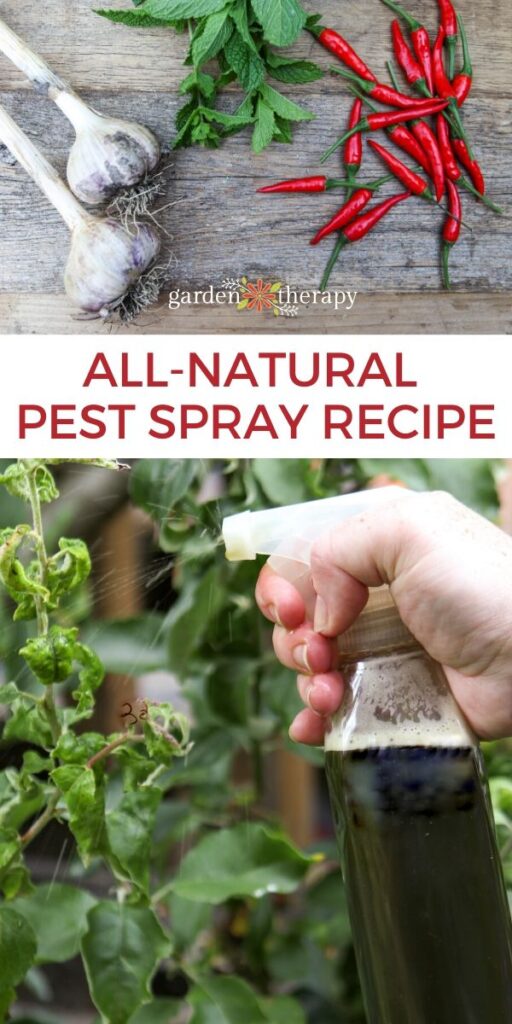
There’s a lot of things we want in our gardens – blooming plants, pollinators, and sunshine to name a few. Likewise, there are a lot of things we don’t want spending time in our garden. Namely, I’m talking about pests that can damage and even destroy your plants like these aphids.
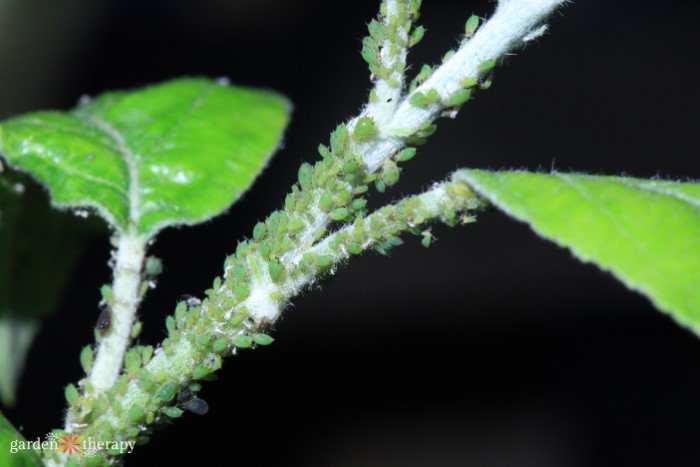
Thankfully, there’s a simple, effective, and economical way to deter these critters from your plants. This homemade herbal pest deterrent spray uses fresh herbs, water, and a bit of soap to keep the pests at bay.
A Natural Alternative to Pesticides
One of the main reasons I developed this natural pest spray is that I don’t like using pesticides or anything that kills insects. I believe every creature has its place…just not in my garden! Pesticides are not only obviously harmful to the pest itself, but can damage the ecosystem of your garden.
Pesticides kill more than “harmful” bugs. They can hurt or deter the good ones too such as helpful pollinating and predatory insects like bees, butterflies, green lacewings, hover flies, and more.
At the end of the day, I don’t want my garden to be full of “cides” that are damaging to insects, plants, and humans—I just want the pests to be deterred from spending time in my garden.
Ingredients in This Natural Pest Spray
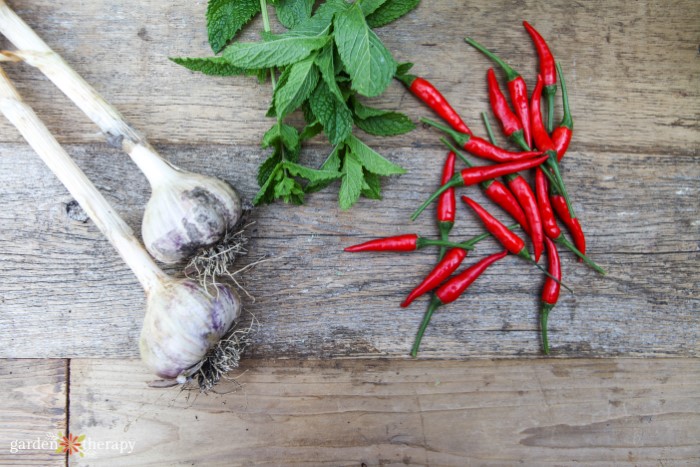
This herbal pest deterrent spray is filled with natural ingredients that naturally deter pests. Interestingly, you can even find these in commercial pest sprays as well. These items have been used for centuries and are proven to be effective! My natural pest spray includes:
Garlic
If you find the smell of garlic pungent – you aren’t alone! Many bugs dislike the smell and will avoid it. Additionally, the smell of garlic may cover the scent of a more tasty plant, helping keep your veggies and flowers safe.
Peppers
Larger pests like squirrels or chipmunks can quickly cause a lot of damage to your garden. The hot peppers in this pest deterrent spray is an effective way to redirect them elsewhere. This spicey ingredient also encourages insects such as leaf beetles to relocate somewhere away from your garden.
Liquid Castile Soap
Liquid castile soap may seem like an odd ingredient but it has a pretty crucial function. Just a little bit of the soap added to the deterrent spray will help it adhere to leaves rather than sliding off.
Chopped Herbs
This is where making your own DIY pest spray becomes quite fun. You can actually tailor this spray to help deter specific insects. This can be tremendously helpful when it comes to protecting certain species of plants that are prone to one insect or another.
I should also mention that some of these herbs can also deter beneficial insects and wildlife from your garden. Use the herbs only when you need to give an intervention to your pest populations. Once they are under control and balance is restored, discontinue use.
Here are the most common herbs I use in this spray and what they help deter:
Basil (Ocimum basilcum)
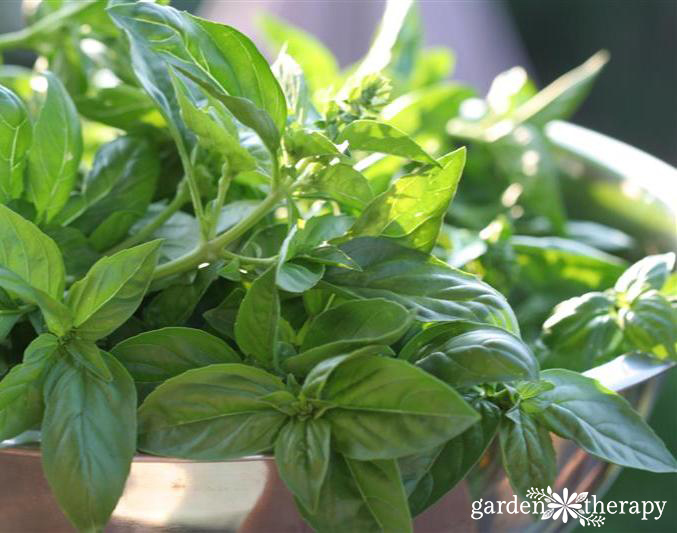
This garden herb can help deter whiteflies, the carrot fly, and the asparagus beetle. I find basil a very rewarding plant to grow as there are so many uses for it! Here are 16 different ways to use and preserve fresh basil.
Borage (Borgo officinalis)
Borage repels the tomato hornworm and the asparagus beetle.
Catnip (Nepeta cataria)
First and foremost, know that the catnip attracts cats to your yard. So, use with caution. On the flip side, it repels a long list of pests including ants, aphids, squash bugs, weevils, cockroaches, and more.
Chives (Allium schoenoprasum)

Chives are great to both grow in your garden and use in this pest spray. It will help discourage carrot flies, Japanese beetles, and aphids from spending time in your space.
Cilantro/Coriander (Coriandrum sativum)
Here’s another herb that makes a great addition to both your herb garden and this natural pest spray. It will help repel aphids, spider mites, and the Colorado potato beetle.
Dill (Anethum graveolens)
Dill will naturally repel aphids, squash bugs, spider mites, and the cabbage looper.
Lavender (Lavandula spp.)
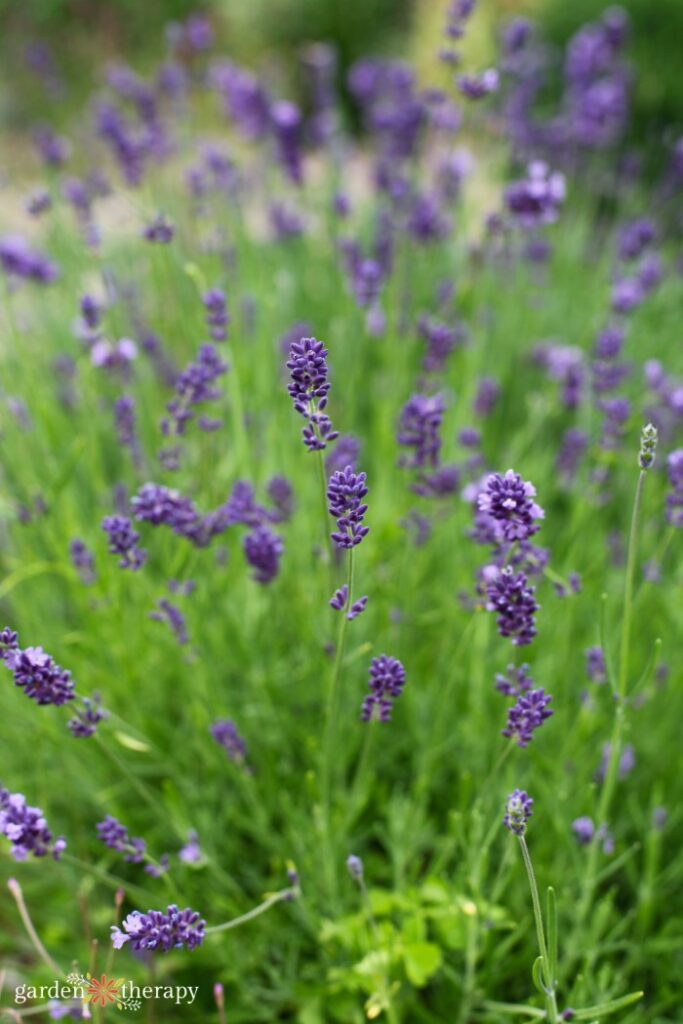
I love lavender (and wrote the ultimate guide on how to grow it)! Not only does it smell amazing and have the most beautiful blooms, but it is an invaluable tool for pest deterring as well. Chopped lavender added to your spray will help repel moths, fleas, flies, and mosquitos.
Mint (Mentha spp.)
This is one of my favorite smelling herbs – but certain pests disagree. Mint will repel ants, aphids, cabbage loopers, flea beetles, squash bugs, and whiteflies.
Pennyroyal (Mentha pulegium)
Ants, gnats, fleas, mosquitos, flies, and mice are just a few of the pests that will be unlikely to visit if you use pennyroyal in your pest deterrent spray.
Rosemary (Rosmarinus officinalis)
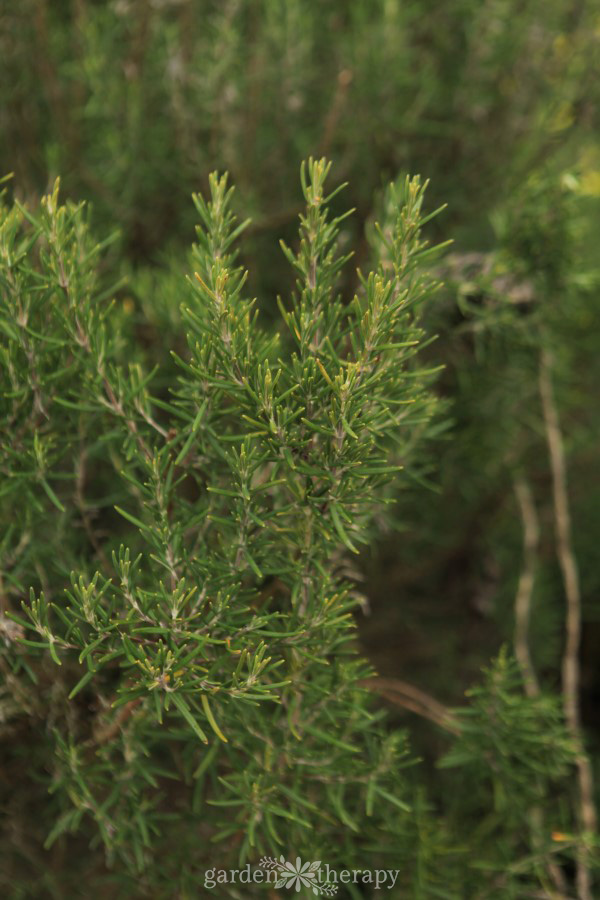
Rosemary is a hardy herb that will also repel its share of pests such as the cabbage loper, carrot fly, cockroaches, mosquitos, slugs, snails, and the Mexican bean beetle.
Rue (Ruta graveolens)
Have a problem with cucumber and flea beetles? Try rue in your pest control spray!
Tansy (Tanacetum vulgare)
Tansy can make a fantastic addition to your pest deterrent spray, particularly if you have ants, beetles, flies, squash bugs, or cutworms making an unwelcome home in your garden.
Tomato Leaf (Lycopersicon esculentum)
Tomato leaf repels many pests, making it a wonderful herb to add to a homemade pest control spray.
Wormwood (Artemisia absinthium)
Ants, earwigs, flies, fleas, slugs, cabbage looper, cabbage maggot, the carrot fly, months, flea beetles, and mice are a few of the pests that can be deterred thanks to wormwood.
How to Make Herbal Pest Control Spray
Now that you have an idea of what to add to your pest control spray, let’s talk about how to make it. Thankfully this recipe is simple to put together.
First, add the garlic and chili peppers, including the seeds, into a blender. Prepare the fresh or dried herbs by removing any leaves or flowers and woody stems (you can add these to your compost pile!).
Secondly, add enough water to cover the mix you made, then blend until it’s completely liquified. Add enough water to fill the blender 2/3 full, then blend again.

Strain the mixture with a nut milk bag. Then give the bag a good squeeze to get all the remaining liquid out. I recommend wearing gloves while doing this to keep your hands safe!
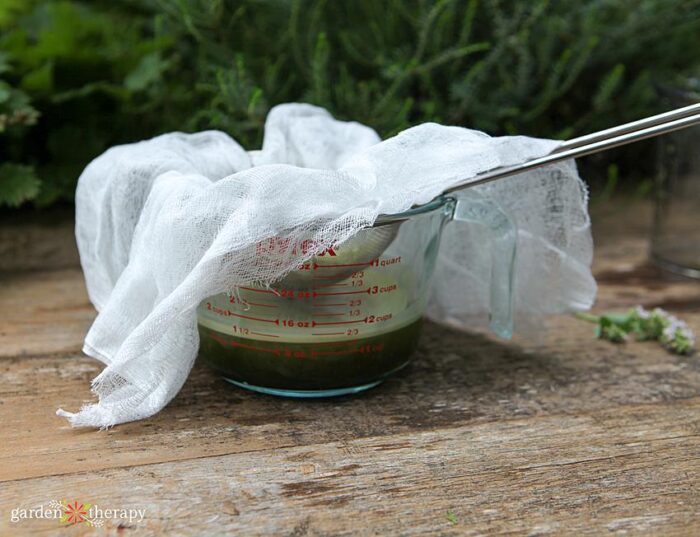
Add a small amount of Castile soap and stir. Some Castile soaps come in a liquid concentrate, so if that’s the case you will need to pre-dilute it.
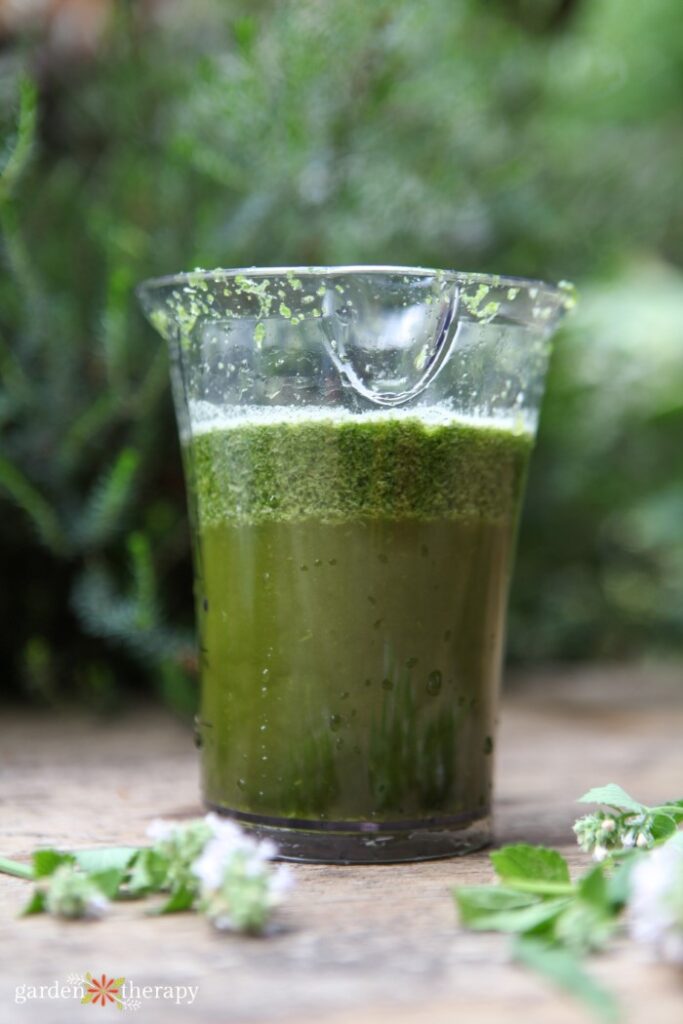
Pour your custom pest control spray into a large spray bottle. Make sure to shake before each use.
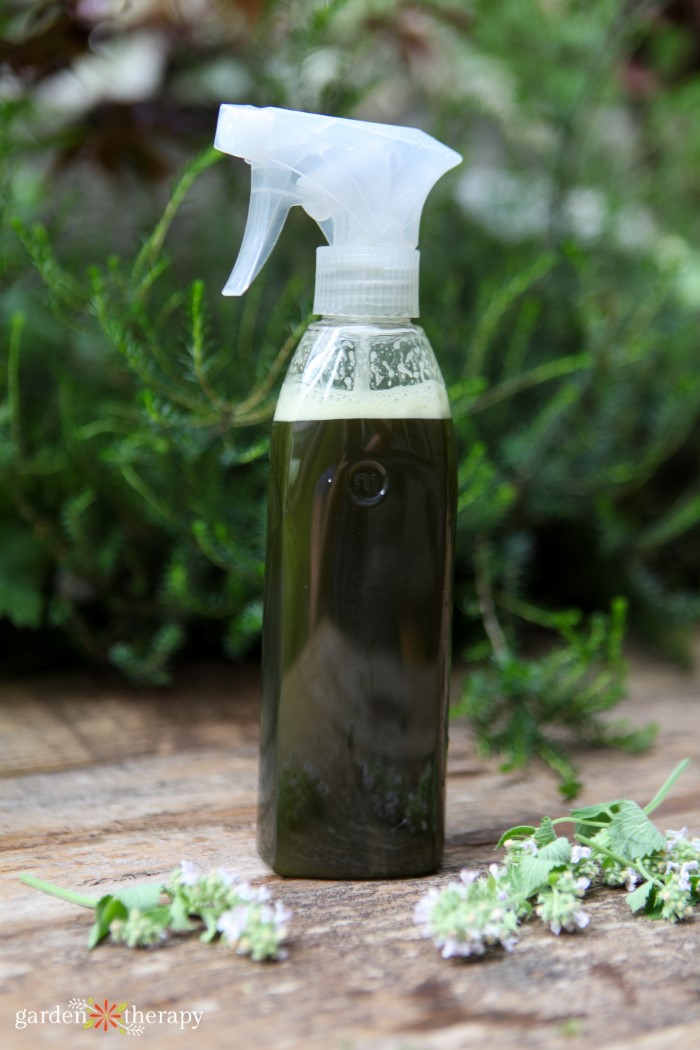
Test a Small Area First
I always recommend testing out a small amount of a homemade concoction like this one on part of a single plant before using it on a broader scale. Watch to see how the plant responds—discontinue if you see any adverse reactions.
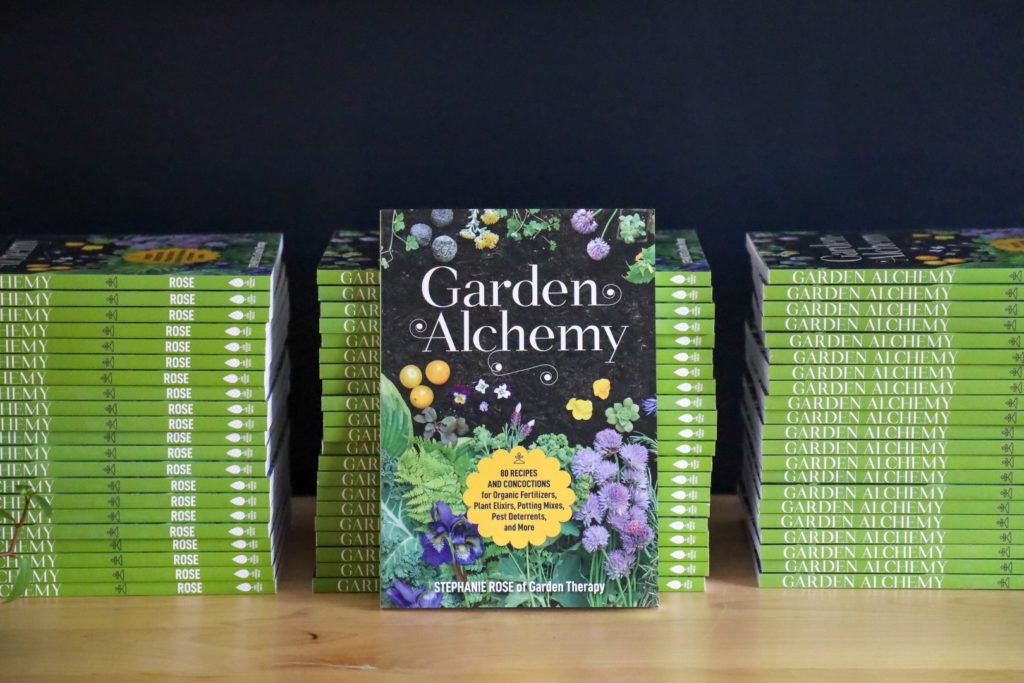
Good Read: Garden Alchemy
I hope you found this natural pest control spray recipe helpful! When properly used, it can help your garden flourish. This recipe came from my latest book, Garden Alchemy. This book is filled with 80 different recipes and concoctions for organic fertilizers, plant elixirs, potting mixes, and more! If you want to help your garden thrive naturally, take a look at Garden Alchemy.
More Posts to Read:
- How to Plant Mixed Herbs and Vegetables to Deter Pests
- Powerful Flowers that Deter Pests Naturally in the Vegetable Garden
- Organic Ways of Getting Rid of Pests in the Garden
Herbal Pest Spray (Natural Pest Deterrent)
Equipment
- Blender
- Nut Milk Bag
Supplies
- 6 garlic cloves whole and unpeeled
- 1-2 whole spicy chili peppers with seeds
- ½ cup chopped herbs optional
- ¼ teaspoon liquid Castile soap
Instructions
- Add garlic cloves and chilli peppers (including the seeds) into a blender.
- If you opt to use any herbs, finely chop the leaves, flowers, and green stems. Do not include any woody stems - compost those instead.
- Cover the mix with water and blend. Add enough water to fill the blender 2/3 full, then blend again.
- Strain the mix through a nut milk bag. While wearing gloves, squeeze any remaining liquid out of the bag.
- Add a small amount of unscented liquid castile soap and stir.
- Pour the liquid into a large spray bottle. Make sure to shake before each use.



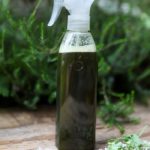



I love your great ideas!
I have so many aphids in my allotment and this formula will be used in my garden.
I made some spray once with garlic only, however I do not know when to apply.
Please how much should I apply and how many times a week? Can it be used any time of the day (full sun)? Shelf life of this product?
Thank you very much for sharing your great knowledge.
Keep safe
Maria
How long can you keep the homemade spray? Refrigerate?
Thanks!
about a week or two in the fridge. It’s intended to be used right away.
Made it and used it today.
The aphids immediately scrambled to get away from the spray.
I hope to see far less out there tomorrow.
Thanks for the recipe.
Thank you so much for sharing this. I’ve been looking for safer sprays for our home and this came at the perfect time. I can’t wait to blend some up. 😀 And I love that it doesn’t kill whatever you’re trying to keep out.
I love your posts! One thing that needs to be said is this: If your garden is working naturally, you won’t have a problem with pests. Insects are part of the ecosystem. Killing one species off, just opens up your yard for another. I left a full blown up infestation of aphids by the advice of a local garden store. It killed me to watch them on my solidago, but they did not harm it. After a few weeks thousands of ladybugs moved in and devoured them all in about 24 hours, then moved on. In my garden in Tucson, the birds happily feast on aphids on penstemons, so I love them when they move in, and they did absolutely no harm to my penstemons. Grow native and leave the bugs. Smiles and love.